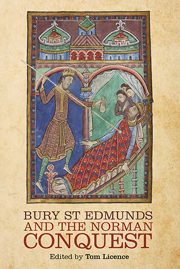Book contents
- Frontmatter
- Contents
- LIST OF ILLUSTRATIONS
- LIST OF MUSIC EXAMPLES
- LIST OF CONTRIBUTORS
- ACKNOWLEDGMENTS
- LIST OF ABBREVIATIONS
- Introduction
- 1 The Abbey and the Norman Conquest an Unusual Case?
- 2 Charters and Influences from Saint-Denis c. 1000–1070
- 3 The Abbey's Armoury of Charters
- 4 The Women of Bury St Edmunds
- 5 Baldwin's Church and the Effects of the Conquest
- 6 New Light on the Life and Work of Herman the Archdeacon
- 7 The Cult of St Edmund
- 8 St Edmund Between Liturgy and Hagiography
- 9 Books and their Use Across the Conquest
- 10 An Eleventh-Century Bury Medical Manuscript
- 11 Medicine at Bury in the Time of Abbot Baldwin
- 12 Medicine After Baldwin: The Evidence of BL, Royal 12. C. xxiv
- Index
8 - St Edmund Between Liturgy and Hagiography
Published online by Cambridge University Press: 05 August 2014
- Frontmatter
- Contents
- LIST OF ILLUSTRATIONS
- LIST OF MUSIC EXAMPLES
- LIST OF CONTRIBUTORS
- ACKNOWLEDGMENTS
- LIST OF ABBREVIATIONS
- Introduction
- 1 The Abbey and the Norman Conquest an Unusual Case?
- 2 Charters and Influences from Saint-Denis c. 1000–1070
- 3 The Abbey's Armoury of Charters
- 4 The Women of Bury St Edmunds
- 5 Baldwin's Church and the Effects of the Conquest
- 6 New Light on the Life and Work of Herman the Archdeacon
- 7 The Cult of St Edmund
- 8 St Edmund Between Liturgy and Hagiography
- 9 Books and their Use Across the Conquest
- 10 An Eleventh-Century Bury Medical Manuscript
- 11 Medicine at Bury in the Time of Abbot Baldwin
- 12 Medicine After Baldwin: The Evidence of BL, Royal 12. C. xxiv
- Index
Summary
The medieval persona of St Edmund, as far as it can be recovered, is generally recognised to have resided in Abbo of Fleury's Passio sancti Eadmundi. Written at the request of the monks of Ramsey at the end of the tenth century, this text was swiftly adopted by the Benedictine community at Bury, where it appears to have been recorded in a booklist from the 1040s, and from whose scribes three eleventh-century copies survive. The Passio was undoubtedly a creative stimulus for the local community, for it gave rise both to the famous cycle of illuminations in the twelfth-century illustrated libellus, now New York, Pierpont Morgan Library, MS M. 736, and to an important collection of eleventh-century chants for St Edmund's feast, which forms the basis of this chapter. Even Bury's late eleventh-century hagiographer Herman owed a debt to Abbo: in alluding to the story of the Passio, commenting on the general shortage of other available accounts, and apparently fashioning his own Miracula as a continuation of that narrative. One might be forgiven for assuming, therefore, that the St Edmund portrayed by Abbo's Passio – the humble, peace-loving figure characterised by Antonia Gransden as a model of Christian kingship – was the very same St Edmund known to the monks of Bury.
- Type
- Chapter
- Information
- Bury St Edmunds and the Norman Conquest , pp. 131 - 159Publisher: Boydell & BrewerPrint publication year: 2014

